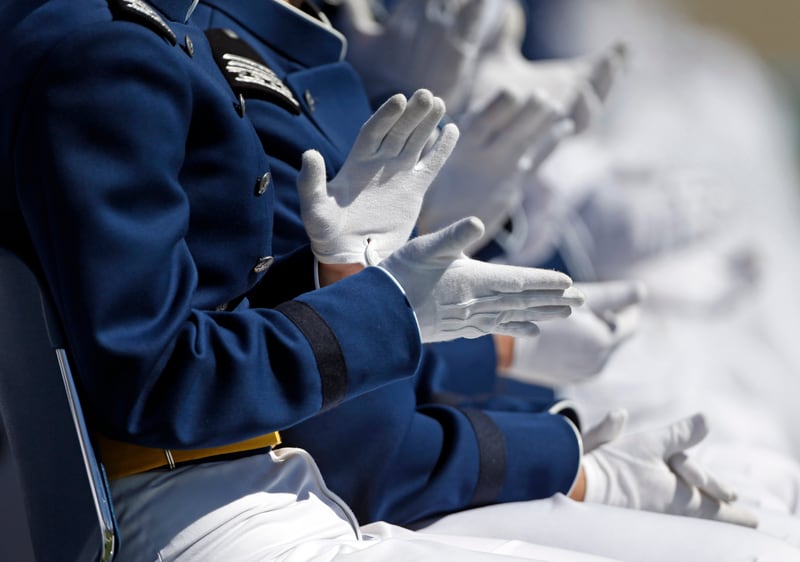
This story was originally published May 22, 2015, at 12:23 a.m. EST.
ABOARD THE FRIGATE SAMUEL B. ROBERTS, Mayport, Fla. – Senior Chief Gunner's Mate Tom Reinert was standing watch by his 76mm gun topside in the sweltering Persian Gulf heat when the deck below him buckled. He was driven to his knees.
"I looked aft, and everything behind the mast was just a wall of flame, towering up into the sky," Reinert recalled.
His first thought was that the ship was going down. There was no way a ship the size of the frigate Samuel B. Roberts could endure such a huge blast and survive. But after that, as flaming pieces of insulation and debris rained down, his thoughts immediately shifted to one thing: damage control.
Reinert, like the rest of crew, jumped into action.
The Sammy B was in desperate straits, and the nearest U.S. ship was nearly 100 miles away.
A cheap, Russian-designed Iranian mine had shattered the keel and knocked out the power. Within 90 seconds, the frigate had taken on nearly half its total displacement in water — two main spaces completely flooded.
It was April 14, 1988: the day USS Samuel B. Roberts, on her maiden cruise, should have sunk in the Persian Gulf but was saved by a herculean effort.
For the next four hours, the Sammy B's beleaguered crew waged a fight for survival that stands as a testament to the simple truth that a well-trained, well-led crew can overcome seemingly impossible odds. The lessons have been passed down to successive generations of Roberts' crew members through the ship's traditions and, even as the ship prepares to retire from active service on May 22, it's a legacy that will live on.
Accounts from crew members and news reports from the time reveal a crew that was close to fanatical about preparation, and leaders at every level who instilled the idea that Roberts sailors were the best in the fleet and would act accordingly.
"The decisions that saved the Roberts, 90 percent of them happened in the weeks and months and even years before the ship hit the mine," said Brad Peniston, author of the book "No Higher Honor," an account of Samuel B. Roberts' fight. "Because they were, from the get-go, a really proud ship, determined to be the best ship they could. And they had internalized that being the best ship meant getting ready to do damage control."
This is the story of how the crew of the Samuel B. Roberts lived up to its ideals and cemented its own place in history, through the eyes of those who witnessed it and those who carried on the ship's legacy.
The ship is scheduled to be decommissioned May 22 in Mayport, Florida, on May 22.
![FFG 58: A sense of heritage[ID=27652873] ID=27652873](http://bcdownload.gannett.edgesuite.net/militarytimes/44862801001/201505/3043/44862801001_4245540593001_4245467719001-vs.jpg?pubId=44862801001) 'Go trace it'
'Go trace it'
The Samuel B. Roberts was built in 1986 at Bath Iron Works, Maine. It was the third ship to carry the of its name.
The first Samuel B. Roberts, DE-413, attained legendary status in the Navy for leading a suicidal torpedo run on an infinitely superior Japanese force off the Philippine island of Samar.
For more than an hour, Sammy B., a small destroyer escort, "fought like a battleship" before being sunk by shells from the Japanese battleship Kongo, taking 89 of her crew to the bottom with her. The Roberts and her sister ships in the task force stopped the Japanese advance and saved countless U.S. troops fighting under Gen. Douglas MacArthur on the island of Leyte.
The second Sammy B. was a Gearing-class destroyer, commissioned in 1946. It and served the fleet for 24m years, being struck in 1970 and sunk a year later as a target.
In early 1986, FFG-58 was still unfinished when the crew began to assemble.
Engineman 2nd Class Mike Tilley, then a young fireman with a sharp wit and propensity for ending up at captain's mast, remembers his time with the pre-commissioning unit Roberts vividly.
Tilley grew up in the "Missourah" area of Missouri and joined the Navy in 1985, following in the footsteps of his older brother.
"I was getting out of high school and, looking around, there weren't a lot of jobs around here — not back then," Tilley said in a May 16 phone interview. "I saw a lot of the guys around me were getting jobs down at the local gas station pumping gas, and that's what there was to do if you stuck around. So I said, 'I've got to get out and do something.' "
After boot camp and at the end of "A" school, Tilley received orders to the PCU Samuel B. Roberts, the third ship in the Navy to bear the name of a coxswain who posthumously received the Navy Cross for saving Marines by drawing Japanese fire at the Battle of Guadalcanal.
Tilley arrived at the Roberts nearly a year prior to its April 1986 commissioning and, like the rest of the crew, remembers filling time at Bath Iron Works by intimately learning every space on the ship.
"Chief would hand me a diagram card of the piping and say, 'Here, go trace it. Learn it,' " Tilley recalls. "This was the time before any of the spaces were classified, so I got to learn all the piping in the missile magazine, combat information center, radio — the whole ship."
The ship's chief engineer, retired Capt. Gordan Van Hook, recalled the period during a speech at a 2006 Surface Navy Association meeting. The workers at Bath Iron Works went on strike for a time, and while it delayed Sammy B's construction, the crew seized the opportunity to have unencumbered access to the unfinished ship.
"Not only did we roam our entire ship, we roamed throughout the others in various states of construction, conducting [damage control] scavenger hunts and rallies and competitions to test each other's knowledge of not just damage control, but the entire layout of the ship," Van Hook said.
"This created a remarkable sense of competition and enthusiasm in the crew. Everyone wanted to show their expertise and try to stump their buddies on facts and layouts that seemed trivial to some, but proved invaluable when we really needed it."
GMCS Reinert said he relished the opportunity to get the crew ready, free from the operational constraints of an active-duty warship.
"We used the time we had," he said. "If there was training the guys could go to, they were going."
It was also during this time that the crew members got to know their damage control assistant, Lt. Eric Sorensen. Van Hook described Sorensen as a man with laser-like focus on whatever he was tasked to do.
"Eric was not universally loved on the ship," Van Hook recalled. "He was not a charismatic leader. When he bore-sighted on something like damage control training, it could be to the exclusion of all else. He was a downright pain in the ass. He was a pain in the ass to everyone, especially me as the chief engineer."
But Sorensen had been hand-selected by Roberts' captain, Cmdr. Paul Rinn, for those very qualities. Rinn wasn't a damage control guru, as Van Hook noted, but the skipper recognized his shortcomings. So he recruited someone who would devote himself fully to the job and whip the crew into a damage control machine, capable of rapidly containing the ship's foremost existential threats: fire and flooding.
Sorensen was more than up to the task, and by the time the crew left Bath Iron Works, it was well on its way to becoming a waterfront damage control leader.
But if Van Hook remembered Sorensen as a "pain in the ass," Tilley remembered a different term the crew used to describe knew Sorensen by.
"We called him the damage control Nazi," Tilley said. "The problem with him was that there was never a rest.
"When you were in the duty section, the rest of the guys were out having a good time, you were back on the ship running drills. If we got underway, as soon as we secured from sea and anchor detail, 'Set General Quarters.' It was constant, just all the time."
![Audio-CaptRobertCopeland [ID=27729619]](/Portals/_default/Skins/PrestoLegacy/CommonCss/images/embed.jpg)
![DN-SC-87-06412 [ID=27744875]](http://www.gannett-cdn.com/-mm-/521cd80a4fb9f1f1edf37d025629b379daee5bba/r=500x332/local/-/media/2015/05/21/GGM/NavyTimes/635678345850781588-Stark.jpeg)
Samuel B Roberts (FFG-58) was commissioned April 12, 1986, and spent the next months in shakeouts and workups.
Then, as now, certifying a crew for operational duties was an arduous process. The culmination of months of training came in the late fall of 1987, when the frigate sailed to Fleet Training Group Guantanamo Bay, where the ship certified its combat systems and, ultimately, aced its mass conflagration drill.
"I'm not even going to try and be modest when I tell you we beat every record they had down there," Rinn recalled in a May interview.
At the time, a recent tragedy loomed large: the May 17, 1987, attack on the frigate Stark that claimed the lives of 37 sailors.
During the height of the Iran-Iraq War, an Iraqi fighter, perhaps mistaking Stark for an Iranian frigate, fired two Exocet missiles into Stark's port side, setting off a blaze that took a bloodied crew hours to contain.
At Guantanamo Bay, the Fleet Training Group was determined to make sure that crews would be ready for an unexpected attack.
"The last thing they threw at us was a mass conflagration [drill] that was similar to the Stark," Rinn recalled. "They threw everything at us that had happened to the Stark. They took the power offline; it took the Stark nearly 3.5 hours to get power back online, it took us 32 minutes.
"The message they sent back to [Naval Surface Force Atlantic] was, 'We threw everything we could at those guys and they beat it.' "
On the return trip from Gitmo, the crew learned the ship had earned the Battle "E," an honor bestowed on ships that excel at their missions.
It was also ordered not to return to its homeport of Newport, Rhode Island, but instead was to join a large fleet exercise in the Jacksonville Operations Area off the coast of Florida.
Sailors know what that means: a deployment on the horizon.
Sure enough, as the ship returned home, the order came down that Sammy B's maiden voyage would be to the Persian Gulf to support the newly minted Operation Earnest Will, the escorting of Kuwaiti tankers, which had become targets of opportunity in the Iran-Iraq War.
Before leaving on deployment, however, Rinn, Van Hook, Sorensen and the executive officer, Lt. Cmdr. John Eckelberry, made sure they had learned the lessons from the Stark.
The ship collected double the required number of oxygen breathing apparatus outfits and OBA canisters on board. Sammy B also had three times the requisite AFFF barrels on board (a soapy, foaming agent used to smother fires), and it had a hand-held infrared fire-finder. All those were recommendations gleaned from the Stark's near-sinking.
The crew also departed with plenty of gas-powered P-250 pumps, which can be used for pumping out flood water if the ship's on-board pumps failed, or for an emergency source of firefighting water if the ship's firemain fails.
"We definitely had more than we were authorized to have on board," said Eckelberry. "We actually had to get creative — we ordered repair parts and had our guys build them."
Thanks to the ruse, the ship had two extra P-250 pumps and, for Rinn, those extra steps ahead of deployment would mean the difference between life and death.
"P-250s can be music to your ears," Rinn remarked at a 1990 damage control conference, according to the April/May 1990 issue of Surface Warfare Magazine.
"Every day underway I demanded reports on the status of my dehydrators and on my P-250s, such as, How many did we run last night? And how many are we running tonight? And how many are online? You think that's redundant? I'm here to say that Roberts is alive today because we did that."

The Sammy B's sailors affixed its shiny new Battle "E" to one of its exhaust stacks and prepared for its deployment to Earnest Will.
"When we got to the [Persian] Gulf, we immediately started running convoys," Rinn said. "And we were headed back from our 14th such convoy on the 14th."
The Sammy B was supporting special operations forces in the Northern Persian Gulf that day when it was ordered to rendezvous with the combat stores ship San Jose for a resupply mission.
The frigate was going as fast as its single screw could carry it on a course of 132 when it reached a spot almost precisely in the center of the Persian Gulf, still about 100 nautical miles from San Jose, the nearest friendly ship.
"We were a long way from anything good," Eckelberry said.
The way Rinn tells it, he was in his stateroom giving the chief cook a hard time about too much spinach on the menu.
Rinn jovially accused the chief cook of a supply goof-up, ordering six cases of spinach instead of six cans.The chief copped to the error.
"And we were laughing about this, and the ship started to shudder," Rinn recalls. "A commanding officer — or anyone that has been on a ship a long time — knows: If you are going high speeds and then everything comes to a stop, you know something's wrong and it's usually right in front of you."
Then the phone rang.
Rinn doesn't remember the conversation with the officer of the deck; he only remembers hearing the word "mine." He dropped the phone and scrambled up to the bridge.
When he arrived, the OOD pointed out a chilling sight: Two mines off the starboard bow, and a mine just 350 yards off the starboard beam.
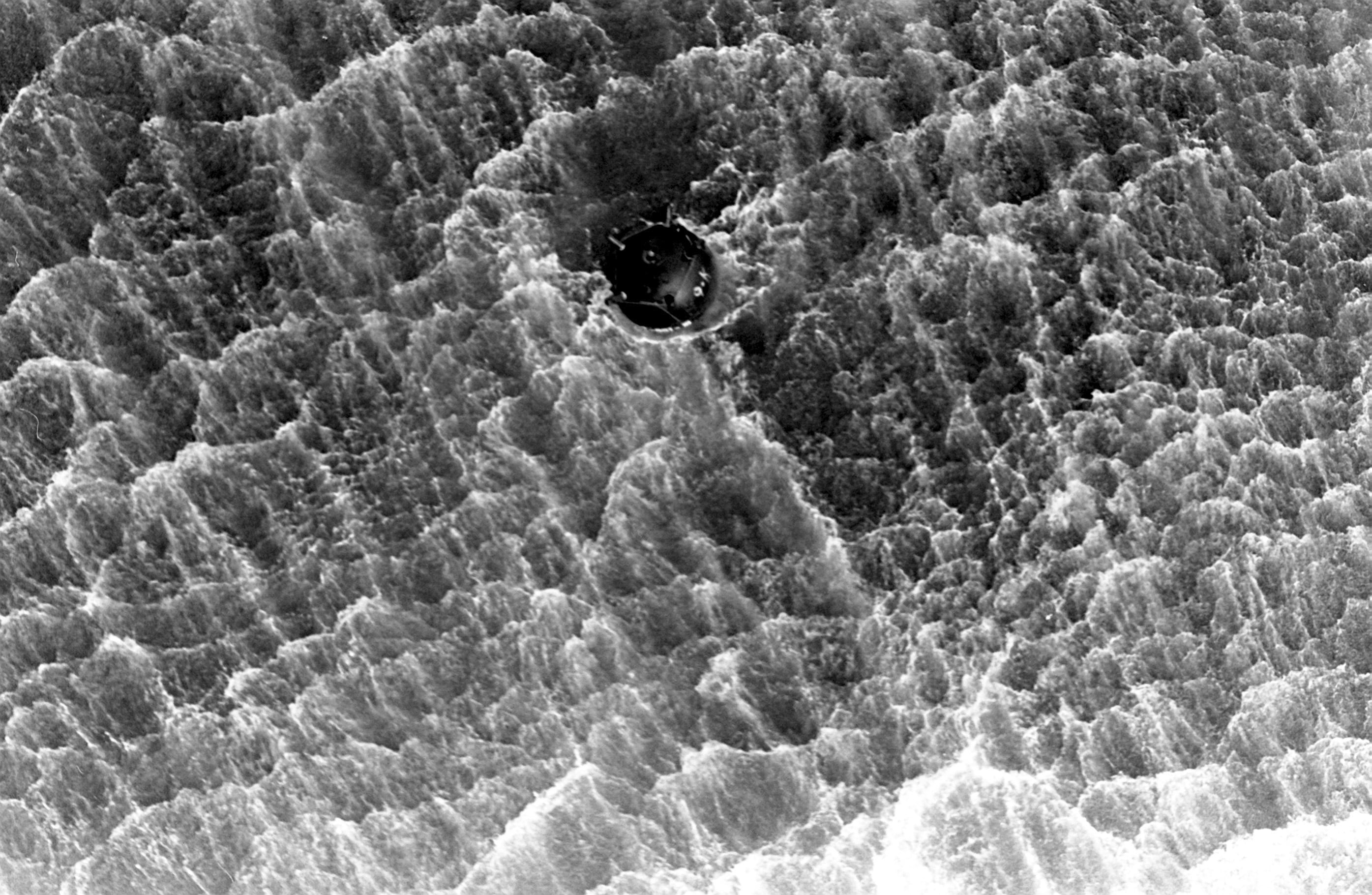
An overhead view of an Iranian mine found in international waters. The frigate Samuel B. Roberts struck a mine while patrolling in the same area on April 14, 1988.
Photo Credit: Cpl. John Hyp
Rinn got on the 1MC general announcing circuit to tell the crew that Sammy B was in the middle of a minefield.
He ordered the ship to set general quarters, set water-tight boundaries throughout the ship, get above the main deck and report in. Once the ship was manned and ready at its battle stations, the frigate would back down its own track to exit the minefield.
The churn of a ship's screw can leave long wake trails; as Rinn looked back, he could see Sammy B's for miles.
"Well, we came in this way, we didn't hit anything, we ought to be able to get back out," he thought to himself.
Chief engineer Van Hook remembers that Rinn did not order the GQ alarm sounded, and said that decision conveyed the deadly seriousness of their predicament.
"The captain manned battle stations immediately upon sighting the mines, but he did it without sounding GQ," Van Hook said. "Sound crazy? Let me tell you, when the CO comes on the 1MC and calmly and deliberately tells you the situation and tells you that he wants you at your battle stations quickly and quietly, with minimal confusion, it has an immense effect. … He wanted to minimize confusion while maximizing our readiness.
"We honestly had not drilled for being in the middle of a mine field, but the CO understood when procedures needed to be modified. … Consequently, our DC teams manned quietly and seriously, and knew that this was the real deal."
It was at that moment that young ENFN Tilley, along with some shipmates, made a choice that would be fateful in the harrowing minutes ahead. He stayed below.
"Tilley reported that he was coming up above deck, but decided there was a real good chance we would need No. 1 diesel," Rinn recalled, referring to one of the ship's massive diesel generator's that provide electrical power. "We've got four; if the ship gets hurt there is a real good chance we will need this one.
"So he reported he was coming up above the main deck but instead he stepped outside the space, closed the hatch then closed himself into auxiliary machinery room 1 – incredibly brave. If the mine had gone off under [Auxiliary Machine Room] 1, there wouldn't have been anything left of him."
Once the ship had set GQ and everyone was on station, Rinn set watches all around and ordered the ship to back up.
He was on the starboard bridge wing looking aft 45 minutes later when his world blew up in front of him.

"It's hard to conceive of being in command of a ship that takes this much damage," Rinn recalled. "So when I ask about the damage and they say, 'We've got no more main engine room,' I think, 'Come on, what's the real story.' "
The reports were bleak. Auxiliary machine room 3, which housed the ship's fresh water supply and a diesel generator, was flooded to the waterline. The ship's main engine room, the largest space on the ship, was flooded up to the upper levels. And auxiliary machine room 2, which housed two generators, had holes and a large crack through which water was rushing.
On top of that, huge tanks full of fuel and oil disgorged through the main engine room, the housing modules around both main engines were obliterated, and when the fuel hit the red-hot metal, it ignited a blaze.
"In the space of about 90 seconds we took almost 2,000 tons of water on the ship, and it was about 15 minutes before sunset," he said. "I thought, 'Great, there goes the light, now we are on fire and we're sinking.'"
Rinn knew a few things for sure: Three of his four electrical generators were flooded or in peril of being underwater. 1GEN was offline, having been shut down earlier for repairs. The ship was dark and night was approaching. He had dozens of wounded, at least four with severe burns who needed immediate aid. Some of them needed to be airlifted out to survive.
Rinn also knew that if he lost AMR2, Samuel B. Roberts had a one-way ticket to the bottom of the Persian Gulf.
"You can't survive on a FFG if you lose three main spaces," Rinn said. "Flood one out and you are in bad shape. Flood two and you are in big trouble. Lose three and you're done."
The situation was worse than any of them knew.
There was a 25-foot gash in Roberts' hull. The keel and superstructure were riven in two, and the Roberts was being held together by the main deck, which flexed with each passing wave.
In "No Higher Honor," Peniston compared the main deck to a soda can getting bent back and forth repeatedly. If it kept happening too long, the ship would break apart and sink.
Less than an hour earlier, at 4:50 p.m., Rinn had been on the bridge wing, weighing the odds of getting out of the minefield alive. He thought Roberts would escape unscathed.
"Imagine looking at the floor, then all the sudden it's 15 feet above of you," he said. "The fireball was remarkable. Then it all just came crashing down. It shattered anything that was horizontal on the ship — counters, Plexiglas, a table — just shattered. The superstructure actually separated from the main deck by about a foot and a half, then when it came back it just compressed down."
Eckelberry's first thought was that the ship's helo, which was turning on deck, had exploded. From his vantage point on the bridge, he couldn't see the flight deck. But word spread quickly that it had been a mine, though nobody had seen it prior to detonation.
The XO recalled that his first reactions were all instinctive, without any emotion: Where are we? Where is the closest ship? How bad are we hurt? How many wounded?
But what he saw next filled him with pride.
"Within seconds, I saw the signalmen forming up a hose team," Eckelberry said. "They moved so fast. You know how people say you see these things in slow motion? I guess it was kind of like that, I saw it in slow motion. But what I remember was how fast they were moving. It was like that throughout the whole process. A lot of great reactions."
The blast sent burning jet fuel, oil, lagging, along with sundry pieces of the main engineering spaces, rocketing up through the ship's exhaust stacks.
"None of us could believe what we were seeing," recalled Electronic Warfare Specialist 2nd Class Fernando Cruz. "There was flaming lagging and debris raining down on the deck and smoke everywhere. ... We took cover immediately under the SLQ-32 antenna and, as soon as the debris had all come down, I shouted, 'Let's go!' then hit the deck and started hauling hose down to the stack area where the flames were."
On the flight deck, the blast stopped the helo's motor and sent fluid spewing onto the nonskid. The air crew immediately thought they had a fuel leak — another potential fire hazard.
Throughout the ship the crew was in motion. Repair lockers sent out investigators, hose teams were forming, and engineers were taking stock of what equipment they had left.
Shortly after the explosion, three watchstanders who were in the main engine room and in AMR3 — the flooded spaces — limped into the ship's engineering central control station. They were badly burned and in need of medical attention.
Moments later, one of the engineers entered the rapidly flooding main engine room and discovered a fourth severely burned victim, wandering the dangerous space disoriented.
On the flight deck, the air detachment was combing over the helo to check that it was ready to fly, to airlift the severely wounded.
Within about 10 minutes, the engineers brought one of the generators in AMR2 back online, but it was running slowly. The other was spewing lube oil into the bilge and was, for the all intents and purposes, out of the fight for now.
With the single generator, the ship had enough power to run the lights but not much else.
"We had power, but not nearly enough to do all the things we needed to do," Rinn said.
The battle to save the Samuel B. Roberts was underway, with its outcome very much in doubt.
In the opening hour of the Roberts' ordeal, Rinn realized he had an unwelcome guest: the Iranian frigate Sabalan.
The Sabalan had been mirroring the Sammy B's course. The crew knew about the Sabalan because of some sporting run-ins they had in the Strait of Hormuz.
"We had driven her back into port and stopped her attacks down there," Rinn recalled. Now, it looked like the tables had turned. Roberts was a stricken ship — the mine had hit less than an hour earlier, and Sabalan was beginning to close.
Rinn and Eckelberry were nervous and suspected that Sabalan was up to no good.
"My XO looks at me and says, 'You know, if we keep letting him come in on us, we'll find out how big the minefield is," Rinn recalled, with a laugh. "I told him, 'I don't think he knows.' "
With the Sabalan within five miles, Rinn decided it was time to take action. So, with limited power, he ordered his combat information center to deal with the unwanted visitor.
"I told my CSO to get a missile on the rail, linked the missile with the radar, and ordered combat to warn the Sabalan that Sammy B was ready and able to fire if it didn't clear out," Rinn said.
He also sent a similar warning to an Iranian maritime patrol aircraft that had taken an interest in the Roberts.
The combat system worked, and Sammy B was once again a coiled snake ready to strike — a white missile on the ship's single rail launcher visible to the Sabalan in the failing light of the evening.
Both Sabalan and the P-3 turned away.
"I think they were coming to finish us off, and I wanted them to know that they weren't going to do that today," Rinn said.
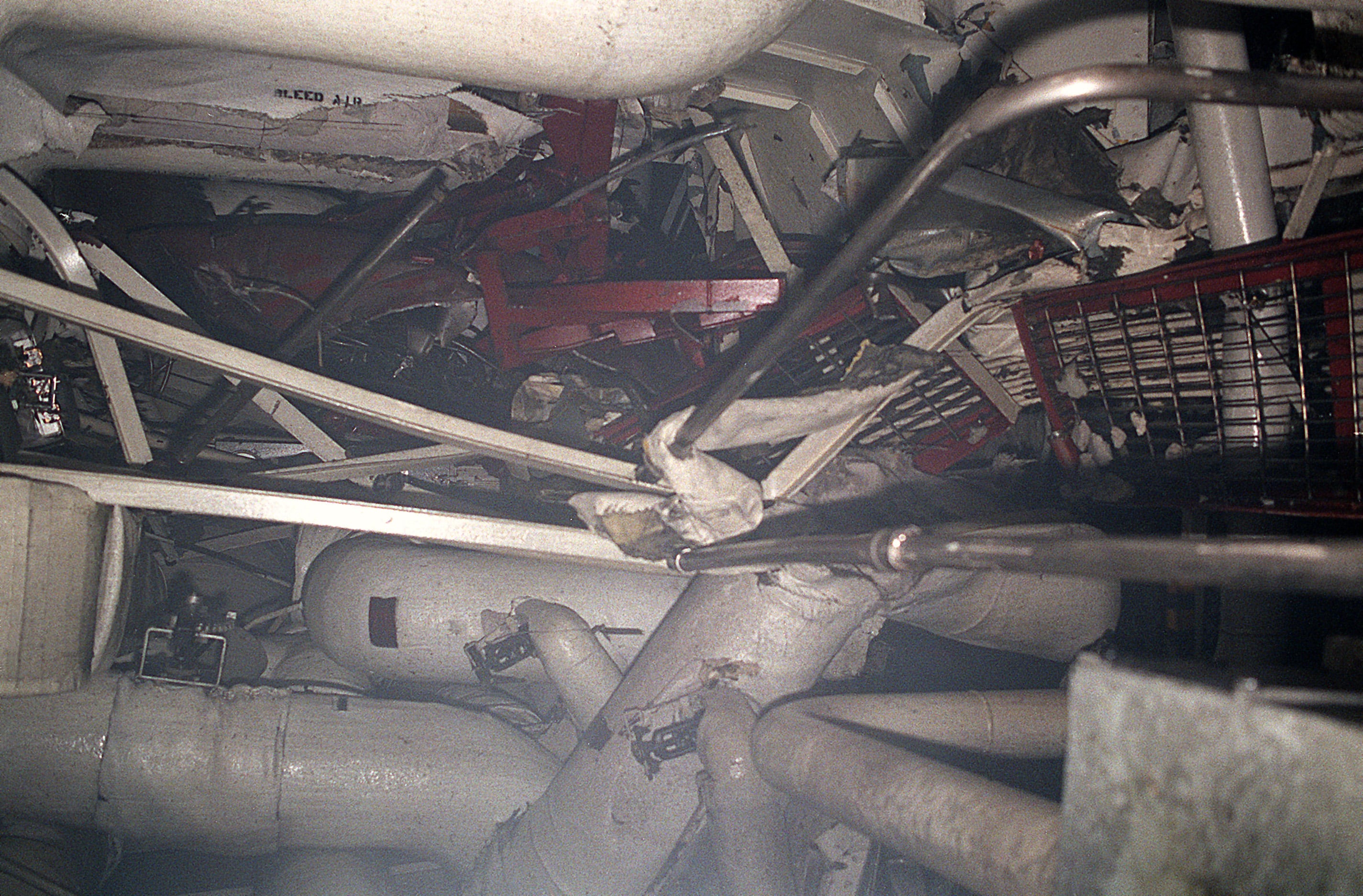
The blast tore through the ship's hull and bulkheads, completely flooding two main engine rooms.
Photo Credit: PH2 Rudy D. Pahoyo/Navy
After the blast, the ship lost firemain pressure. Thinking quickly, the repair parties rigged two P-250 pumps and began pumping seawater to douse the flames. Other pumps were rigged in flooded spaces to pump water over the side.
Because of the damaged electric plant, neither the firemain nor the P-250s were producing enough pressure to foam up the AFFF, and the pools of fuel swirling in the spaces were moving the blaze around.
With the fires advancing and firemain pressure to fight them drastically low, GMCS Reinert knew he had to make sure his ammunition magazines weren't in danger of cooking off. All was fine until he discovered the magazine where he stored his 76mm ammo for the ship's main gun.
It was hot. Very hot.
The magazine's temp was 115 degrees and rising.
He reported to the central control station, the engineering hub then quarterbacking the damage control effort, that he needed help in the magazine. Within minutes he got word from the CO to deep-six the ammo.
Eckelberry helped Reinert organize a working party that humped ammo out of the magazine and tossed it into the water.
"We didn't have to look very hard for volunteers that night," Reinert said. "Everyone wanted to help out in some way."
Meanwhile, the fight to save AMR2 was at a critical point. Not long after the explosion, one of the repair lockers had sent a five-man team there, led by Chief Mess Specialist Kevin Ford — he of the spinach goof.
Within the first half hour of the blast, Rinn knew he was losing — Sammy B was sinking at a rate of about a foot every 15 minutes.
He decided to go visit the crew in AMR2.
As Rinn descended the ladderback, he encountered a sailor who Rinn knew best for his struggles to keep his weight down. He was stripped to his skivvies and carrying a mattress.
He asked, "Hey, what are you doing?"
"So he looks at me with this expression like, 'Can't you see I'm busy?' and moved on without answering."
Rinn followed the man down into the space. Water reached up to his shins and was pouring through the fractured bulkhead. A thought flashed into his mind: "It's worse than I thought."
He saw why the sailor was in his skivvies. He'd wrapped his dungarees around tool boxes and stuffed them into two holes about the size of dinner plates.
"He'd stopped about 90 percent of the flooding just like that," Rinn recalled. The fracture was still letting in water, however, so mattresses from the chiefs' mess were being used along with shoring to stem the flooding.
Rinn knew their plight was critical. The cracked bulkhead looked as if it would burst at any moment. His hodgepodge repair party, which lacked so much as a single engineer, was doing the best it could. But to Rinn's mind, it looked like they had about a 40 percent chance to save the bulkhead — to save the Samuel B. Roberts.
Rinn gathered his men and told them they had to save the bulkhead at all costs.
"You have to save this space," he said. "We've lost AMR3 and we've lost the main engine room. If you don't save that bulkhead, we're going to go down and you are going to die here. I'm not telling you that to scare you, I'm telling you that because if you can't handle it, tell me now and I'll replace you."
In truth, Rinn had nobody in reserve to take their place. But he got the response he expected: "You've got other things to worry about, we've got this space."
To Rinn, 27 years later, that moment still has a profound effectimpact on him.
"As I was leaving the space, I told them, 'All right, I got you. We're in your hands.' And as I got to the ladder I thought to myself, 'I'll never see these guys alive again.' "
As he was leaving the space, he began hearing the strains of 1970s rockers Journey from a tape deck one of the sailors set up. It was an inside joke among the crew that Rinn's biggest fear was to find one of his crew members with his daughter in a Trans-Am, blasting Journey.
Rinn ducked his head back in the space.
"Even now, your taste in music still sucks," he said.
As Rinn ascended, the lights overhead flickered out.
"Oh great, that's it, we've lost power and we're going to have to abandon ship," he said.
A moment later the lights came back on brighter than before.
Though they didn't know it, ENFN Tilley and his friends in AMR 1 had just tipped changed the odds in Sammy B's favor.

At 4:49 p.m. Tilley was sitting on the upper levels of AMR1 with fellow Fireman Joe Baker and Engineman 2nd Class Randy Tatum on antique metal milk jugs that for some reason were in the space.
A minute later they were lifted off their seat by the force of the mine blast but were set back relatively gently.
"Like everyone else, I thought it was the helo," Tilley said.
For a moment they all just looked at each other. Then the lights went out. When they smelled smoke, they knew it was time to act.
"The fire and smoke blew up through the stacks when the mine went off, so the smoke had come down to our space through the exhaust," Tilley remembered. "But we didn't know, we thought it might have been our space that was on fire."
The emergency battle lanterns didn't light up automatically, so they pulled out the battery operated, handheld ones and set out to find the source of the smoke.
They opened the enclosure around the generator and saw smoke drifting out of the exhaust duct — the stacks had been set ablaze by the explosion.
That's when they heard the 1MC announcement that the ship had hit a mine and was on fire.
Tatum, Baker and Tilley knew they had to start the 1GEN, but they also knew it was offline for a reason. Earlier in the day, before the strike, the generator had triggered an overspeed alarm and was shut down.
They knew one more thing, and that was that the lights were out and the ship needed power.
Armed with a battle lantern, Tilley wriggled into the enclosure around the massive generator and looked around. He found the problem was a cracked speed governor in the generator.
Knowing the damage to the generator, the team raised central control on the sound-powered phone and asked if they should start the broken generator.
"The answer was something like, 'F--- yes, we want you to start the generator, we have to get power to the ship!' " Tilley said.
The problem with that was the panel they needed to start 1GEN was dead, like virtually everything else.
Tilley knew there was a way to do it, but he wasn't thrilled about it: the suicide start.
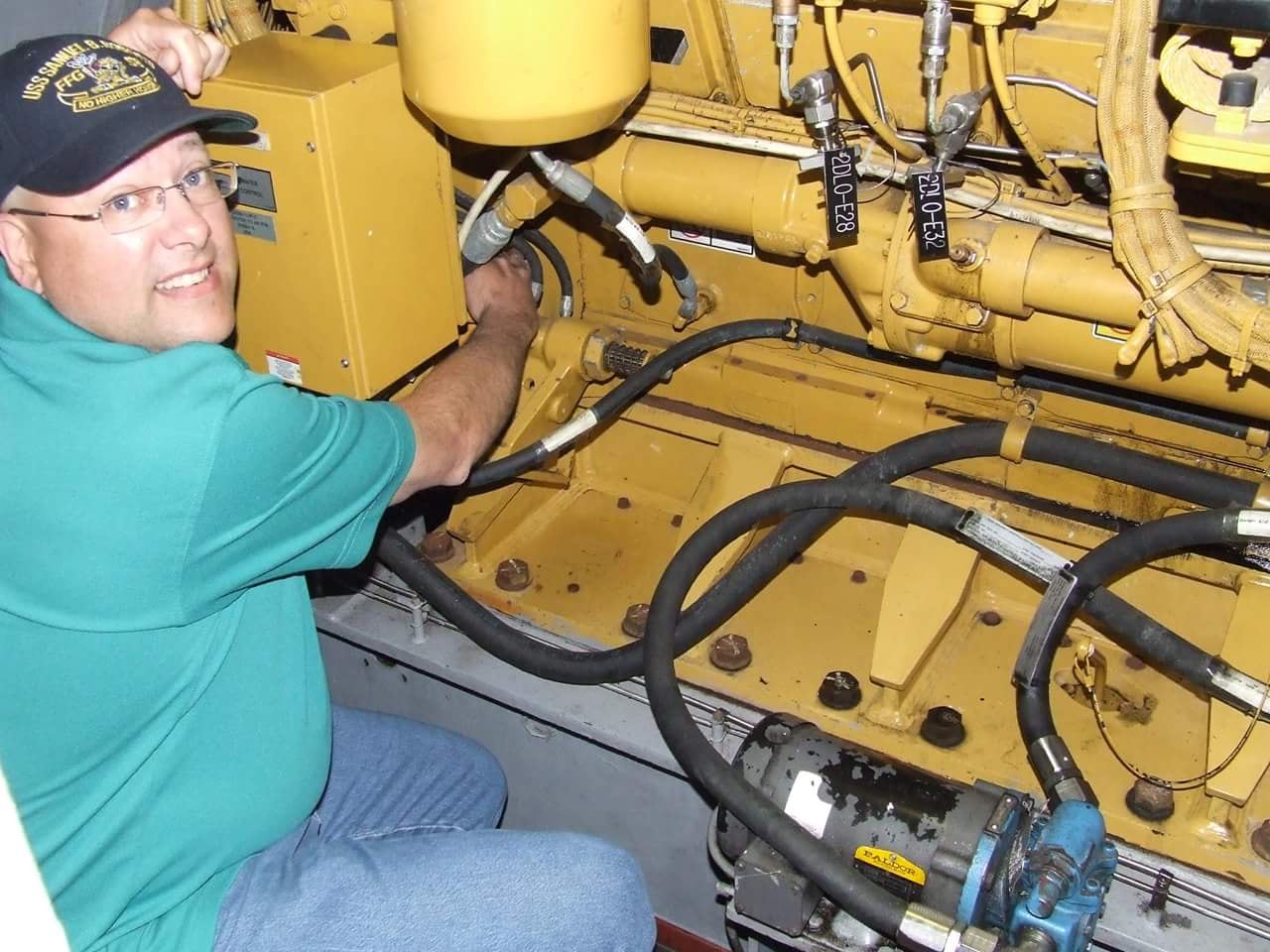
Former Fireman Mike Tilley re-enacts his famous suicide start of No. 1 generator on board Samuel B. Roberts.
Photo Credit: Courtesy of Michael Tilley
Diesel generators start with a blast of high-pressure air that turns a fan on a starter motor, which in turn starts the big generator. The suicide start switch was inside the enclosure, beside the generator. What he had to do was go in and depress a plunger, releasing an emergency flask of HP air that would kick on the generator.
"We only really had one shot at it," Tilley said. "One of the things that I'm not sure many people know is that we only had the one flask left; the rest were empty."
Tatum manned the switchboard and prepared it for the generator start, but Tilley was concerned about the overspeed problem, when an engine runs beyond its design limit.
"With the cracked governor I was worried the thing would start running away on me, and I'm inside [the enclosure]," he said.
There was really nothing for it. The one generator in AMR2 and its leaking counterpart in the same space weren't producing enough power to run the pumps for the firemain, the eductors educators dewatering the spaces, not to mention the overhead lights.
This wasn't optional — the ship's success rode on getting 1GEN online.
With a deep breath, Tilley depressed the plunger.
WHAM. The generator kicked on, but instead of overspeeding, it was running too slowly. The switchboard operator needed more juice to power the system.
Tilley clambered on top of the generator, still worried about the cracked governor, and adjusted the control bolt to the required 60 Hertz.
Tilley has a tendency to downplay this, partly because he spent the rest of the night babysitting his generator and drinking grape soda.
"I was going crazy down there," he said. "I wanted to leave and help fight the fire or help out with the flooding. But every time I'd call to central and ask to leave, they'd say, 'No, we need you down in AMR1.' "
Rinn has another view of it.
"If Tilley doesn't get No. 1 generator started, we're going down," he said. "We were going to lose the ship."
About an hour into the fight, the air detachment reported that they checked the helo thoroughly and there was no fuel leak — they could fly.
After a few turns around the stricken Sammy B, the helo landed, loaded the most seriously injured crew members and headed at top speed to the San Jose.
The damage control effort was going full tilt, but Sammy B was still sinking.
Eckelberry's mind was already drifting toward what the crew ship needed to do to abandon ship. It was time to start thinking about emergency destruction of the encrypted codes and machines the ship used for communications.
But in the XO's view, the crew was in high spirits and putting up one hell of a fight.
"So I went up to the captain and said, 'Sir, I don't think we should start destroying the codes. I think that would signal to the crew that we're losing,' " Eckelberry recalled. "He just looked at me and said, 'Oh yeah … Yeah, let's not do that. F--- the code.' "
Then, in a clear and calm voice, Rinn got on the 1MC. His words were recorded by one of the junior officers.
He commended the crew and told them to press the fight. Two ships were coming fast, but the nearest was still 70 nautical miles away and he wouldn't let it enter the minefield to try and save them. The crew members of the Sammy B were on their own.
"We have got to fight this problem ourselves," Rinn said. "We don't know what the size of the minefield is, and I'm not really excited to have two guys come in and have the same thing happen to them as happened to us.
"So we're going to have to hang in there like Samuel B. Roberts guys and fight this thing on our own. We're doing fine now. Keep charging and keep your heads up."
An hour and a half into the struggle, the situation was dire and taking its toll.
The fires still raged in the main spaces and in the stacks. Reinert recalled that the hose teams kept the fire from spreading, but progress was slow.
According to a NAVSEA reconstruction of the event, Sammy B had many of its dewatering systems back online. The firemain was returned to more normal levels after Tilley and his band had started No. 1 generator. The engineers had scraped some capacity out of the two generators in AMR2 and the shoring in the space — mattresses and all — was holding while the eductors kept pumping water out of the besieged space.
The mattresses and shoring effort, though it was surely not a method they learned from Fleet Training Group, was successful. It stopped the flooding in AMR2 and they managed to dewater the space.
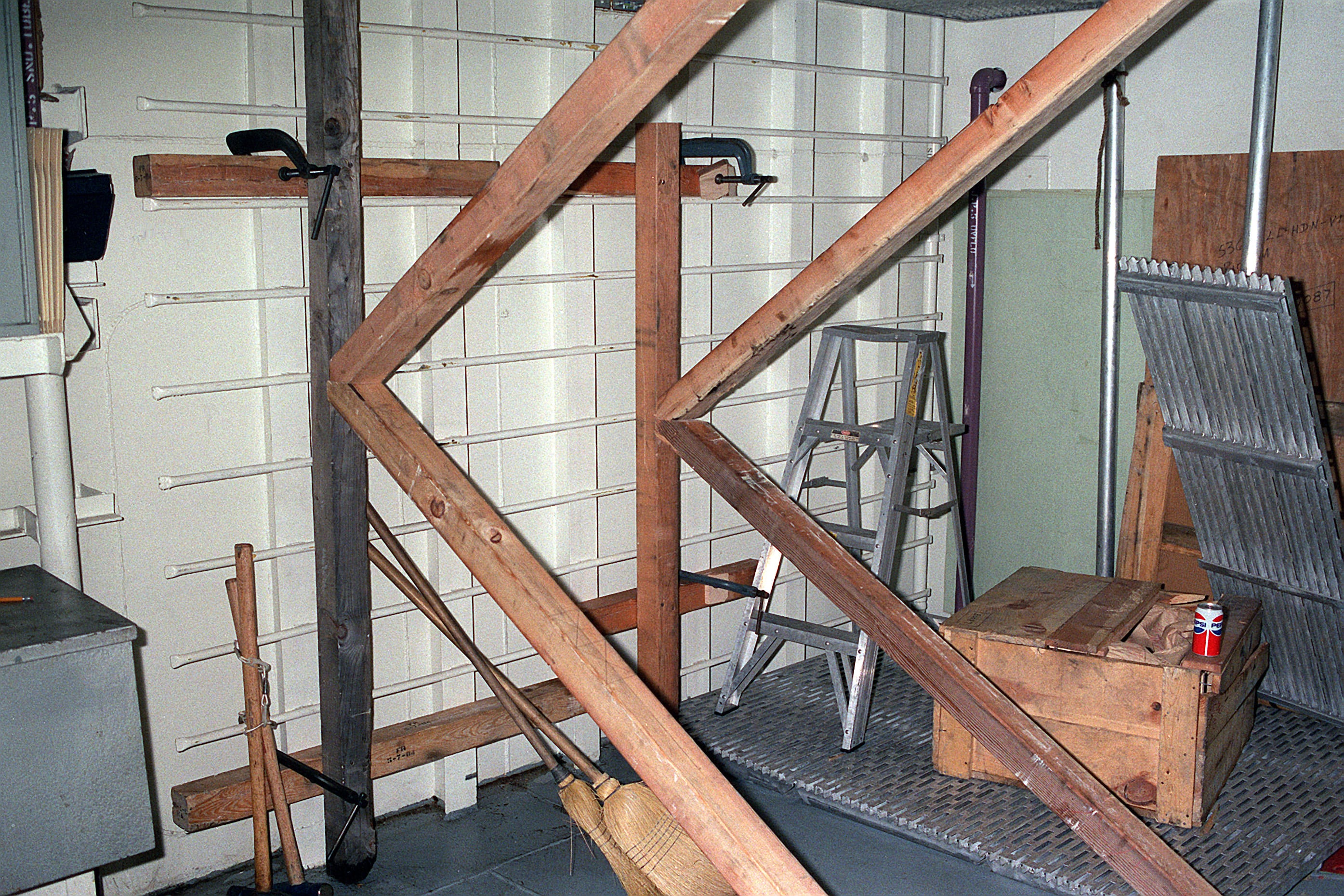
The crew fought flooding by emplacing K-type shoring, as well as using tool boxes and even their uniforms to stem the water pouring in.
Photo Credit: PH2 Rudy D. Pahoyo/Navy
Still, the hull continued to sink.
Rinn had posted a BM2 he trusted on the fantail to report back on where the water level was. Over the ship's comms net, the lookout reported some bad news.
"Sir, if I get down on my hands and knees, "I'm pretty sure I can put my hands in the Persian Gulf."
Rinn was also getting soaked by the firefighting water coming down through the overhead — a result of the hose team's efforts to contain the fire.
"So I'm standing there and my shoes are filling up with water and all the sudden it hits me," he said. "We're sinking ourselves!"
It was another lesson from the Stark. During the desperate fight to stop the fire, the crew sprayed so much water that it nearly caused the ship to roll onto its side.The Stark took on an 18-degree list and the dewatering systems couldn't keep up. At one point, one hard wave could have sunk the Stark.
"I'm going, 'Oh my God, it's the Stark all over again,'" Rinn said. "We're doing exactly what they did. We're so desperate to fight the fires we're not thinking about [staying afloat]."
Rinn scrambled to the bridge and barked out an order over the 1MC circuit: "Cease fighting all fires."
He hung up the mic and felt a hand on his shoulder. It was Eckelberry, asking Rinn if he would step out on the bridge wing.
"Have you lost your f---ing mind?" he asked.
Rinn looked at his XO and said, "John, if we don't stop putting water on the ship, in about half an hour they'll be out because we'll be underwater, and the Persian Gulf is going to put them out."
Eckelberry rogered up and went back to work. Within 15 minutes, Sammy B stopped sinking.
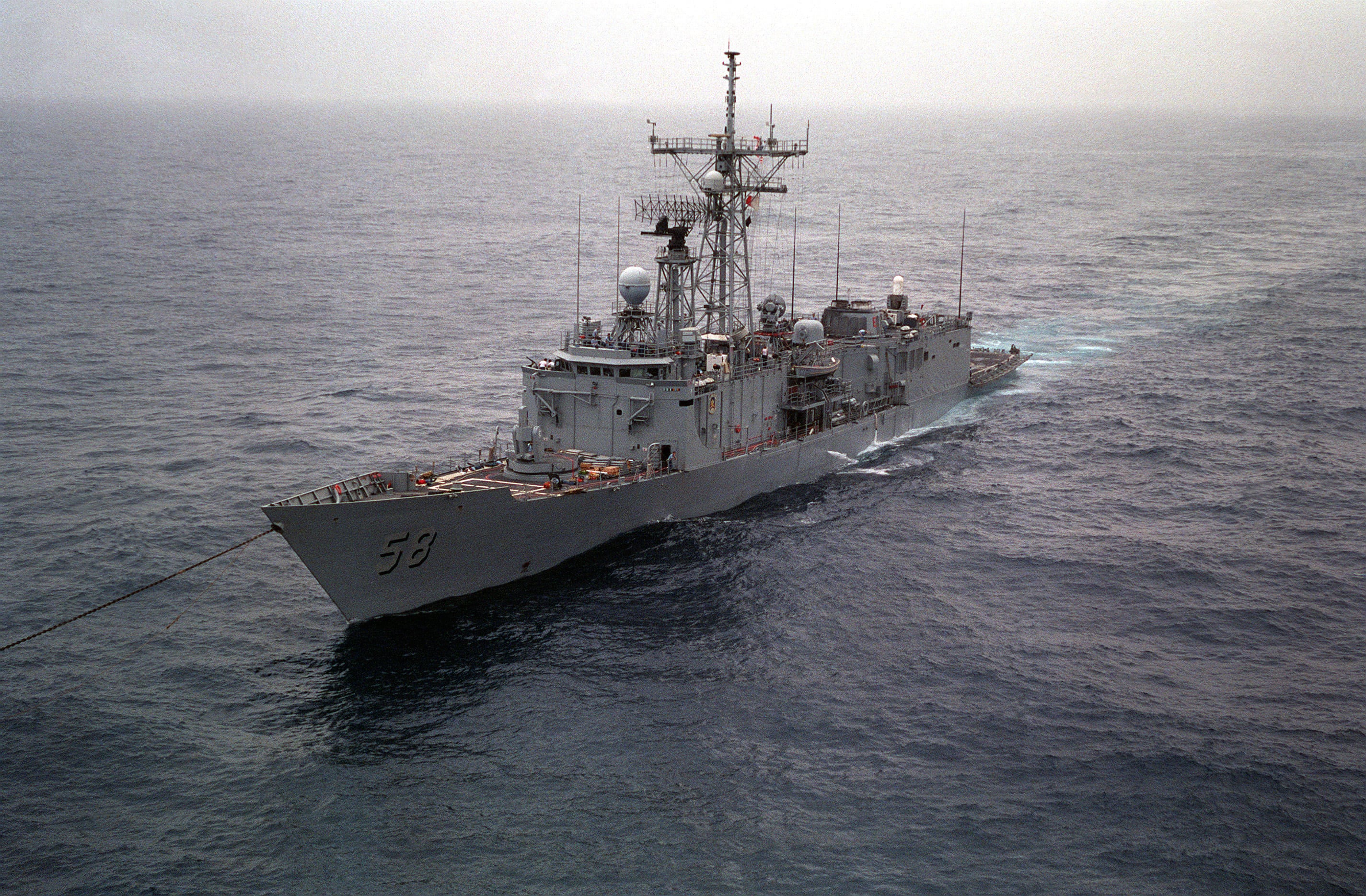
The frigate was towed into port a day after striking the mine, which broke the ship's hull and nearly sank it.
Photo Credit: PH2 Rudy D. Pahoyo/Navy
Two hours later the crew was exhausted.
"It was like overtime in a hockey game," Rinn said. "You could just see they didn't have much left. You know you hear these jocks say, 'We left it all on the field'? Well this was that, we had left it all on the field."
But with the ship still burning, they couldn't stop.
Van Hook was determined to get the fire out, so he entered the main space and did some investigating. It turned out that fire was concentrated below two large plates on the ship's superstructure that could be removed if the ship needed to switch out an engine.
Rinn and the hose teams were on the weather deck when a hatch opened behind them, smoke and sparks billowing forth. Out popped the chief engineer.
"Nice entrance, CHENG," Rinn thought.
"I know how to get the fire out," Van Hook said, explaining that they needed to removed the access plates off the stacks and put AFFF directly on the fire's source.
Rinn wasn't sure.
"I told CHENG that I was very concerned about this because I didn't want to give oxygen to the fire — I thought I could suffocate the damned thing," he said.
Van Hook prevailed and, faster than anyone thought possible, the sailors got the plates off.
"So they pulled the plates off and WHOOOSH, a tower of flame comes up, singes all our eyebrows," Rinn said. "So I turn around and Van Hook is behind me, protected. He says 'Huh, maybe that wasn't the right thing to do.' "
It was a joke, Rinn recalled with a chuckle. Within minutes, the fire was out.
They had won.
After four hours of tremendous struggle and effort, the crew had saved the Samuel B. Roberts.
"It was this tremendous moment of achievement," Rinn said, as tears began to well in his eyes while recalling the day 27 years ago. "There was this a subdued roar that went throughout the ship — the word spread very fast that the fire was out.
"Two hundred-odd guys who had been in death's grip for the past four hours had achieved a triumph."
Rinn passed the word to stand easy on station, and the crew collapsed where they stood.
Eckelberry and Rinn ordered everyone to sleep out on deck.
"We still kind of thought we were going to sink," Eckelberry said.
For Tilley, what struck him was how subdued the crew was on deck. "I just remember how peaceful it was," he said.
Reinert recalled that peaceful time on deck together as the moment that forged the bond in the crew that has lasted to this day. (Reinert, who lives in Florida, currently heads the Samuel B. Roberts reunion group.)
Not many words were passed, but they knew they had done something incredible.
"For me it was that next morning, watching the sun come up," he said. "It was just this feeling like, wow, we're here — we did it."
The Sammy B had lost its main engines. The single screw propulsion system was rendered worthless by the mine strike. During the night, 10 Roberts sailors were evacuated for emergency medical treatment, several having to be flown back to the military's elite burn unit at the Brooke Army Medical Center in San Antonio.
Earlier in the evening, once it was clear that the ship wasn't sinking anymore, Rinn went to the bridge and cleared the chart table. Though he has no idea how he settled on the course, he ordered the ship to fire up its auxiliary propulsion system and come to course 146.
The course was good. The Sammy B steamed through the night in safety while the crew rested.

At first sighting on an overcast and muggy March morning in Jacksonville, the Samuel B. Roberts looked like any other Oliver Hazard Perry-class frigate in the fleet — the boxy frame showing its nearly three decades of age.
The ribbon cluster just under the starboard bridge-wing — the same one Capt. Paul Rinn was standing on when the ship blew up in his face — commands attention. It bears the normal cluster of Battle "E,"Meritorious Unit Commendation and National Defense ribbons. But alone, on top of them all, is the Combat Action Ribbon.
The CAR is something of a white buffalo among sailors — a rare decoration in a fleet that hasn't been in sea combat against a competitor since World War II. It's a badge of honor.
Sammy B is one of the last ships with the distinction.
It's been more than 27 years since 200 men on the frigate saved her from sinking to the bottom of the Persian Gulf after the Iranian mine that broke her keel, punched a 25-foot hole in her hull and flooded two main engine rooms.
It's a fight that they shouldn't have won, many experts say.
"Every analysis that has ever been done on the Samuel B. Roberts mine strike since has said that ship should have been on the bottom of the ocean. But it's not, and that's because of the men serving on that ship, on that day," said Vice Adm. Tom Rowden, head of Naval Surface Forces, in a May 15 phone interview.
"They refused to let that ship die."
The Sammy B is set to leave the service May 22, and so in March the crew was preparing the ship to be dismantled. For the crew and for generations of sailors who have served on her over the years, it's a poignant occasion. It is one of the last of the Oliver Hazard Perry-class frigates.
Lt. j.g. Evan Albright — tall and blonde, wearing the blue digital cammies — approached the quarterdeck, which is on the fantail now because mid-ship's quarterdeck is covered in scaffolding.
"Welcome aboard the Sammy B," Albright said, extending his hand.
Albright, the ship's first lieutenant, is the tour guide. The ship's crew was still filtering in from morning command PT.
Walking through the helo hangar, Albright, a recent Oregon State grad, rattled off the ship's missions in a flat Northwesterner's accent.
"The hangar can support SH-60s, but on deployment this is where we kept the MQ-8 Fire Scout," he said.
We walked through the centerline passageway and stopped in front of the wardroom. He pointed to the bulkhead.
"There used to be a plaque there with all the names of the crew from the original Sammy B, DE-413, but we took it down just recently," he said, pausing.
"Yeah, this ship is very, very cool," he said. "It's got a lot of history and everybody just seems to know it when they come. It just has a cool … essence about it."
And he's right. You could feel it.
Though the ship bears no visible scars from its four-hour hellish ordeal, the atmosphere felt charged.
Nobody knows when the tradition started — it was sometime after Rinn turned over — but sailors who check on board as new crewmembers don't automatically get issued their ball caps. Those have to be earned.
"Our ball caps, most ships just give 'em to you when go talk to the [command] master chief," Albright said. "On our ship you have to earn your ball cap. The master chief will come talk to you about the ship's history. … Everyone has to know the history.
"It's almost like the ship has a persona. Everyone who comes here, you want to do a good job, you are on a ship that's actually been through something."
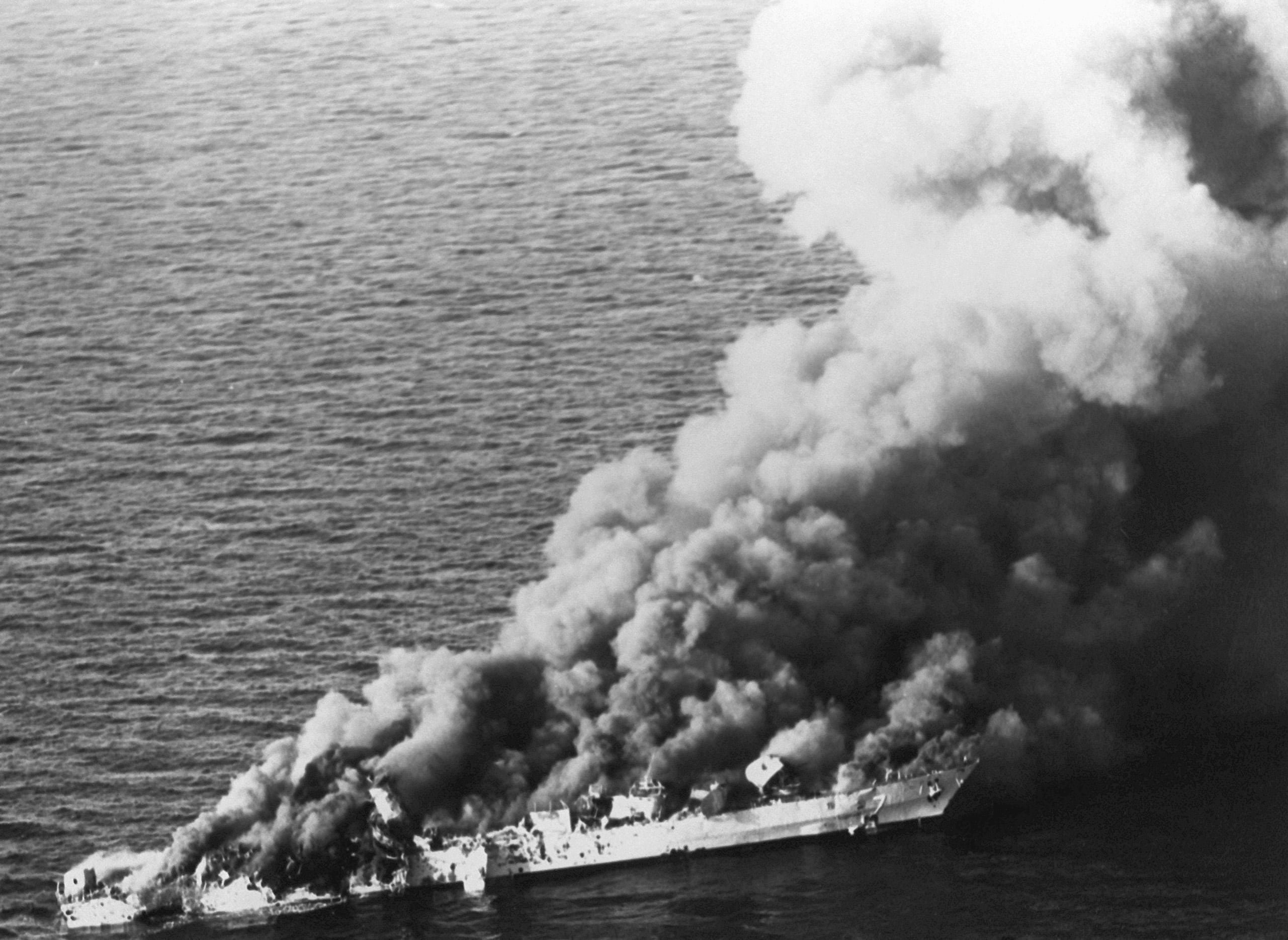
U.S. carrier jets attacked the Iranian frigate Sahand in retaliation for the minestrike on the Samuel B. Roberts. The ship was hit by three Harpoon missiles plus cluster bombs.
Photo Credit: Defense Department
The night of April 14, 1988, had an enormous impact on the men who survived it.
In the days following, the Navy cleared the minefield that bedeviled Roberts and the Reagan administration ordered a series of retaliatory strikes against Iran.
Retired Capt. John Eckelberry went on to command the frigate Ford, and he brought with him a Sorensen-esque fanaticism for damage control.
"We would do some crazy things on that ship," he recalled. "We had these smoke generators and we would flood the whole ship out with smoke. Then we'd shoot the gun — you know, I wanted the crew to hear gunfire and explosions when they were fighting the fire.
"I bet it looked funny, seeing us sailing around with smoke pouring out and shooting the 76mm."
In his command tour, Eckelberry returned to the gulf with Ford. The experience, he said, made him nervous, but he found a creative way of coping.
"We were transiting north," he recalled. "I walked over to the chart table and plotted a point. The [quartermaster] asked, 'Hey captain, what's that?' I said, 'That's a very special place and we're going to drive right through the middle of it.' "
In the years since, people have offered him sympathy for what he and his crew went through but he'll have none of it. To Eckelberry, it's something he's proud to have been a part of.
"I look at it as we did our job and did it well -- we hit home runs all night," he said.
Retired Senior Chief Gunner's Mate Tom Reinert, who is a plant manager in Florida, and runs the Sammy B's reunion group with gusto.
Rinn also returned to the Persian Gulf, as commanding officer of the cruiser Leyte Gulf, named for the battle in which the first Sammy B fought its way to glory.
He retired in 1997 and started a new career in consulting. He now travels the country sharing the story of the Sammy B's fight for survival and the lessons learned.
Among those lessons: "If you want to be the best, you have to work at it," Rinn said. "You've got to practice, practice, practice, and drill, drill, drill."
And ENFN Mike Tilley, the man who saved the ship by starting No. 1 generator when things on the Roberts were at their worst, went on to a career in public works.
He now owns Terre Du Lac Utility Co., which provides water and sewer services to the community of Terre Du Lac, Missouri.
Tilley also leads the local volunteer fire department. He, too, has channeled the single-minded focus of the Sammy B's former damage control assistant, Sorensen, as he trains his volunteers.
For Tilley, the lesson of April 14th is that to be good, as Rinn said, you have to train. But the training can't just be about learning the steps. It must teach people to think fast.
"It's problem solving," he said. "We were taught problem solving in damage control and firefighting because every situation is different. We didn't train to put mattresses in holes, nobody told us that's how you do it. Kevin Ford came up with that on his own because he was focused on problem solving."
But while the story of the fight to save Roberts is a testament to training, that the Roberts struck a n mine in the first place serves as a chilling warning of what the Navy faces in the future as it turns its attention from "blue water" combat to near-shore littoral combat.
The Roberts was nearly sunk by an Iranian M-08 contact mine, cheap Russian design that dates back to before the First World War, Peniston said.
"It shows how simple weapons can do massive damage to a technologically superior force. They cost about a thousand bucks a piece," Peniston said. "You roll 15 of those off its $15,000 but, what did it do? It put a $96 million hole in a Navy warship."
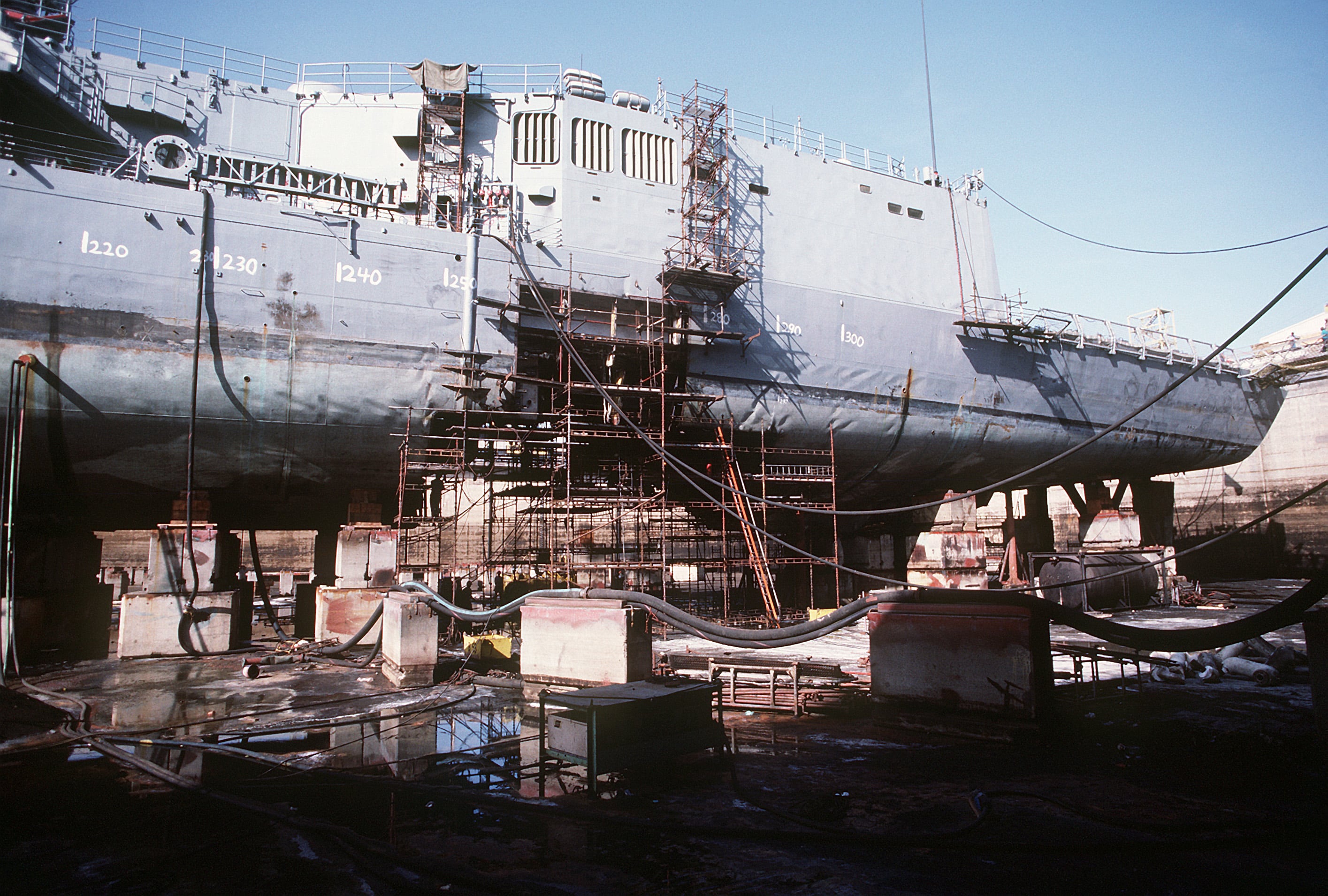
The frigate's hull was ruptured by the Iranian mine. The frigate was drydocked for repairs before it was sealifted back to the U.S.
Photo Credit: PH1 Mussi/Navy
Cmdr. Erica Hoffmann is the Sammy B's last skipper.
A 1996 Naval Academy grad and nuclear-trained surface warfare officer, she greeted visitors as Ens. Evan Albright showed off the at-sea cabin, which is stripped of all its furniture and never to be used again.
One of three women on the ship — frigates remained open only to enlisted men because of berthing constraints — Hoffmann said she has loved serving on the small ship.
"I know every sailor," she said. "With a crew of 200, I could literally walk around the ship and greet every sailor by name. New babies? Show me a picture. You know, any update on that house you were trying to buy?"
For Hoffmann, serving in the footsteps of the '88 crew and its captain is an honor. It's also a reminder of her responsibility to ready the crew for a fight.
"I tell the sailors, 'Any day, anywhere, any ship in the Navy: You never know what's going to happen.' For that crew on FFG-58 during the mine strike, or the crew of DE-413 at Samar, both of those crew didn't wake up that morning with any idea what their immediate future held for them."
"We've got to be ready," she continued. "Are we training enough? Are we focusing on the things we need to be focused on? ... Because this world is a crazy, crazy place."
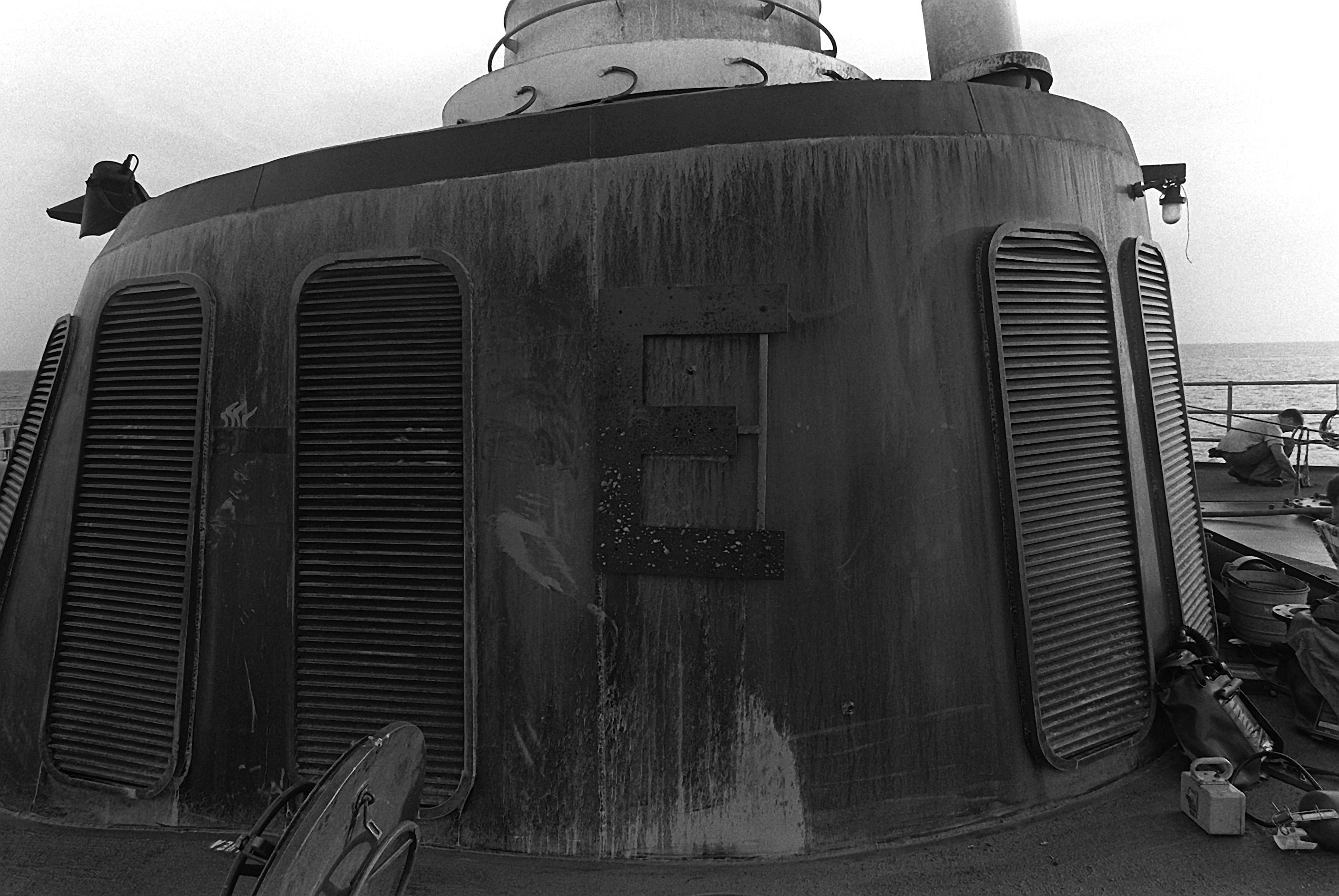
The frigate's Battle 'E' was scarred from the blaze. The crew would earn the Combat Action Ribbon from the mine strike.
Photo Credit: PH2 Rudy D. Pahoyo/Navy
Rowden, the surface Navy's top officer, uses the example of the Samuel B. Roberts often when he's trying to drive home his mantra of "warfighting first," the idea that preparing to fight a war is the fleet's foremost priority.
But to Rowden, it's the legacy of the Samuel B. Roberts name that is truly awe inspiring — one that he expects will continue.
"It's always sad when you decommission a ship," he said. "But this particular ship, its story won't end with the decommissioning. The legacy lives on. The gallantry and the bravery of those men will live on.
"You know, I'm not in the ship naming business, but as we press on and name new ships, I would be shocked if we didn't see Sammy B come up again."
David B. Larter was the naval warfare reporter for Defense News.





